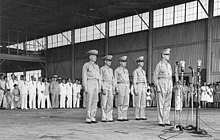Philippine Army Air Corps
This article needs additional citations for verification. (January 2013) |

The Philippine Army Air Corps was created by the Philippine National Assembly's National Defense Act of 1935 in its first legislative act.[1]
General Douglas MacArthur, convinced by his friend Philippine President-elect Manuel L. Quezon and with President Roosevelt's agreement to leave his position as Chief of Staff and become Military Adviser to the Commonwealth Government.[2] MacArthur was given wide authority to deal directly with the United States Secretary of War, his successor as the Army Chief of Staff and the United States Army Philippine Department and its commander Major General Lucius R. Holbrook who had been directed that his most important peace time mission was assisting MacArthur in forming a Philippine force capable of defending the islands.[2] MacArthur selected Majors Dwight D. Eisenhower and James B. Ord as his assistants who, with a special committee at the Army War College, prepared plans to form the national defense of the Philippine Commonwealth with a completion target of independence in 1946.[2] That plan called for a small regular army with divisions of about 7,500 men, conscription with all men between twenty-one and fifty years of age eligible, with a ten year training program to build a reserve army, a small air force and a fleet of torpedo boats capable of repelling an enemy.[3]
The air corps was targeted to have by independence in 1946 approximately 100 bombers and additional tactical support aircraft to be used with the Off Shore Patrol of torpedo boats in coastal defense.[4] When war came the corps had around 40 aircraft and 100 pilots,[5] 500 personnel, and six squadrons. In August 1941, the PAAC was inducted into the United States Army and incorporated into the Far East Air Force.
The first Philippine Commonwealth Army airfield (Zablan Airfield) was built outside of Manila, Luzon in 1935. At this time only three pilot trainers were available in the Philippines. Courses in flying and technical training were given in the mainland United States to selected students. After the war the airfield was closed and became Camp Emilio Aguinaldo.
On 31 July 1941 the corps consisted of 2,132 enlisted troops, under the command of 275 officers:
- Headquarters (109)
- U.S. 4th Composite Group (1,393)
- U.S. 20th Air Base Group (842)
- Tow Target Detachment (42)
- Weather Detachment (21)
Aircraft
As of 8 December 1941
Numbers in () indicate number of aircraft that were usable, where records are available.
Fighters
- Boeing P-12E bi-plane: 2
- Boeing P-26A: 12 [1]
Bombers
- Martin B-10B monoplane bomber: 3 (2)
- Keystone B-3A light bomber: 1
Noncombatant
- Beechcraft D18 (Beech 18) trainer and utility plane: 2
- Douglas O–46 observation aircraft: 4
- Other (mainly trainers): 50
- Stearman A75L3
- PT-1 trainers (73L-3)
- BT-1 monoplane bomber (76D-1) [2]
- Stinson Reliant
- Curtiss O-1 observation/attack biplane
- probably O-19 observation biplane
Aircraft of the Imperial Japanese Army Air Force
These aircraft were part of the 26th Sentai of the Imperial Japanese Army Air Service stationed during World War II:[6]
As of 15 May 1945 through 1 July 1947 and establishment of the Philippine Army Air Force
- North American P-51 fighter: 200
- P-47 Thunderbolt fighter: 480
- T-28 Trojan fighter
- Douglas C-47 transport
- Douglas C-47 ground attack
- HU-16 Albatross transport
- Piper L-4 trainer
- Stinson L-5 light observation/liaison aircraft
Organization of The Philippine Army Air Corps as of 8 December 1941
- Philippine Army Air Corps Headquarters
- 1st Training Squadron
- Zosa's Depot Detachment
- Ramos' Depot Detachment
- Sebastian's Airbase Detachment
- 5th Photo Detachment
- 6th Interceptor Squadron
- Ebuen's Instruction Squadron
- de Leon's Airbase Detachment
- 9th Observation Squadron
- 10th Bombardment Squadron
- Aya-ay's Airbase Detachment
- Primary Flying School
- Basic & Advanced Flying School
- Philippine Army Air Corps Supply
See also
References
- ^ Morton 1993, p. 10.
- ^ a b c Morton 1993, p. 9.
- ^ Morton 1993, pp. 9–10.
- ^ Morton 1993, p. 11.
- ^ Morton 1993, p. 13.
- ^ http://www.pacificwrecks.com/airfields/philippines/zablan/index.html
Bibliography
- Morton, Lewis (1993). The War in the Pacific: The Fall Of The Philippines. United States Army In World War II. Washington, D.C.: Center Of Military History, United States Army. LCCN 53063678. Retrieved 4 November 2014.
{{cite book}}: Cite has empty unknown parameter:|coauthors=(help); Invalid|ref=harv(help)
